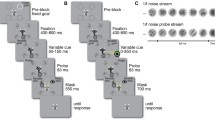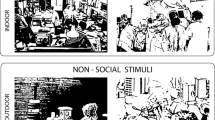Abstract
Although many studies have documented the robustness of eye–hand coordination, the computational mechanisms underlying such coordinated movements remain elusive. Here, we review the literature, highlighting the differences between mostly phenomenological studies, while emphasizing the need to develop a computational architecture which can explain eye–hand coordination across different tasks. We outline a recent computational approach which uses the accumulator model framework to elucidate the mechanisms involved in coordination of the two effectors. We suggest that, depending on the behavioral context, one of the two independent mechanisms can be flexibly used for the generation of eye and hand movements. When the context requires a tight coupling between the effectors, a common command is instantiated to drive both the effectors (common mode). Conversely, when the behavioral context demands flexibility, separate commands are sent to eye and hand effectors to initiate them flexibly (separate mode). We hypothesize that a higher order executive controller assesses behavioral context, allowing switching between the two modes. Such a computational architecture can provide a conceptual framework that can explain the observed heterogeneity in eye–hand coordination.



Similar content being viewed by others
References
von Hofsten C (1982) Eye–hand coordination in the newborn. Dev Psychol 18:450–461
Land MF, Hayhoe M (2001) In what ways do eye movements contribute to everyday activities? Vis Res 41:3559–3565
Prablanc C, Echallier JF, Komilis E, Jeannerod M (1979) Optimal response of eye and hand motor systems in pointing at a visual target. Biol Cybern 35:113–124
Bekkering H, Adam JJ, Kingma H, Huson A, Whiting HTA (1994) Reaction time latencies of eye and hand movements in single- and dual-task conditions Harold. Exp Brain Res 97:471–476
Bisley JW, Goldberg ME (2010) Attention, intention, and priority in the parietal lobe. Annu Rev Neurosci 33:1–21
Roitman JD, Shadlen MN (2002) Response of neurons in the lateral intraparietal area during a combined visual discrimination reaction time task. J Neurosci 22:9475–9489
Steenrod SC, Phillips MH, Goldberg ME (2013) The lateral intraparietal area codes the location of saccade targets and not the dimension of the saccades that will be made to acquire them. J Neurophysiol 109:2596–2605
Cui H, Andersen RA (2007) Posterior parietal cortex encodes autonomously selected motor plans. Neuron 56:552–559
Andersen RA, Cui H (2009) Intention, action planning, and decision making in parietal-frontal circuits. Neuron 63:568–583
Andersen RA, Buneo CA (2002) Intentional maps in posterior parietal cortex. Annu Rev Neurosci 25:189–220
Hanes DP, Schall JD (1996) Neural control of voluntary movement initiation. Science 274:427–430
Thompson KG, Hanes DP, Bichot NP, Schall JD (1996) Perceptual and motor processing stages identified in the activity of macaque frontal eye field neurons during visual search. J Neurophysiol 76:4040–4055
Stuphorn V, Taylor TL, Schall JD (2000) Performance monitoring by the supplementary eye field. Nature 408:857–860
Schall JD, Stuphorn V, Brown JW (2002) Monitoring and control of action by the frontal lobes. Neuron 36:309–322
Song J-H, Rafal R, McPeek R (2010) Neural substrates of target selection for reaching movements in superior colliculus. J. Vis. 10:1082
Cisek P, Kalaska JF (2005) Neural correlates of reaching decisions in dorsal premotor cortex: specification of multiple direction choices and final selection of action. Neuron 45:801–814
Rizzolatti G, Scandolara C, Matelli M, Gentilucci M (1981) Afferent properties of periarcuate neurons in macaque monkeys. I. Somatosensory responses. Behav Brain Res 2:125–146
Rizzolatti G et al (1988) Functional organization of inferior area 6 in the macaque monkey. Exp Brain Res 71:491–507
Munoz DP, Wurtz RH (1995) Saccade-related activity in monkey superior colliculus. II. Spread of activity during saccades. J Neurophysiol 73:2334–2348
Munoz DP, Wurtz RH (1995) Saccade-related activity in monkey superior colliculus. I. Characteristics of burst and buildup cells. J Neurophysiol 73:2313–2333
Fecteau JH, Munoz DP (2006) Salience, relevance, and firing: a priority map for target selection. Trends Cogn. Sci. 10:382–390
Georgopoulos AP, Kalaska JF, Massey JT (1981) Spatial trajectories and reaction times of aimed movements: effects of practice, uncertainty, and change in target location. J. Neurophysiol 46:725–743
Fromm C, Evarts EV (1982) Pyramidal tract neurons in somatosensory cortex: central and peripheral inputs during voluntary movement. Brain Res 238:186–191
Biguer B, Prablanc C, Jeannerod M (1984) The contribution of coordinated eye and head movements in hand pointing accuracy. Exp Brain Res 55:462–469
Sailer U, Eggert T, Ditterich J, Straube A (2000) Spatial and temporal aspects of eye–hand coordination across different tasks. Exp Brain Res 134:163–173
Dean HL, Martí D, Tsui E, Rinzel J, Pesaran B (2011) Reaction time correlations during eye–hand coordination: behavior and modeling. J Neurosci 31:2399–2412
Gielen CCAM, van den Heuvel PJM, van Gisbergen JAM (1984) Coordination of fast eye and arm movements in a tracking task. Exp Brain Res 56:154–161
Herman R, Herman R, Maulucci R (1981) Visually triggered eye–arm movements in man. Exp Brain Res 42:392–398
Fisher B, Rogal L (1986) Eye–hand-coordination in man: a reaction time study. Biol Cybern 261:253–261
Frens MA, Erkelens CJ (1991) Coordination of hand movements and saccades: evidence for a common and a separate pathway. Exp Brain Res 85:682–690
Gopal A, Viswanathan P, Murthy A (2015) A common stochastic accumulator with effector-dependent noise can explain eye–hand coordination. J Neurophysiol. https://doi.org/10.1152/jn.00802.2014
Bizzi E, Kalil RE, Tagliasco V (1971) Eye–head coordination in monkeys: evidence for centrally patterned organization. Science 173:452–454
Lunenburger L, Kutz DF, Hoffmann KP (2000) Influence of arm movements on saccades in humans. Eur J Neurosci 12:4107–4116
Gribble PL, Everling S, Ford K, Mattar A (2002) Hand–eye coordination for rapid pointing movements: arm movement direction and distance are specified prior to saccade onset. Exp Brain Res 145:372–382
Bekkering H, Pratt J, Abrams RA (1996) The gap effect for eye and hand movements. Percept Psychophys 58:628–635
Armstrong IT, Judson M, Munoz DP, Johansson RS, Flanagan JR (2013) Waiting for a hand: saccadic reaction time increases in proportion to hand reaction time when reaching under a visuomotor reversal. Front Hum Neurosci 7:319
Song J-H, McPeek RM (2009) Eye–hand coordination during target selection in a pop-out visual search. J Neurophysiol 102:2681–2692
Fisk JD, Goodale MA (1985) The organization of eye and limb movements during unrestricted reaching to targets in contralateral and ipsilateral visual space*. Exp Brain Res 60:159–178
Lawrence BM, Gardella AL (2009) Saccades and reaches, behaving differently. Exp Brain Res 195:413–418
Thura D, Hadj-Bouziane F, Meunier M, Boussaoud D (2008) Hand position modulates saccadic activity in the frontal eye field. Behav Brain Res 186:148–153
Thura D, Hadj-Bouziane F, Meunier M, Boussaoud D (2011) Hand modulation of visual, preparatory, and saccadic activity in the monkey frontal eye field. Cereb Cortex 21:853–864
Mushiake H, Fujii N, Tanji J (1996) Visually guided saccade versus eye–hand reach: contrasting Neuronal activity in the cortical supplementary and frontal eye fields. J Neurophysiol 75:2187–2191
Oristaglio J, Schneider DM, Balan PF, Gottlieb J (2006) Behavioral/systems/cognitive integration of visuospatial and effector information during symbolically cued limb movements in monkey lateral intraparietal area. J Neurosci 26:8310–8319
Philipp R, Hoffmann K-P (2014) Arm movements induced by electrical microstimulation in the superior colliculus of the macaque monkey. J Neurosci 34:3350–3363
Lünenburger L, Kleiser R, Stuphorn V, Miller LE, Hoffmann K-PP (2001) A possible role of the superior colliculus in eye–hand coordination. Prog Brain Res 134:109–125
Pesaran B, Nelson MJ, Andersen RA (2006) Dorsal premotor neurons encode the relative position of the hand, eye, and goal during reach planning. Neuron 51:125–134
Boussaoud D, Jouffrais C, Bremmer F (1998) Eye position effects on the neuronal activity of dorsal premotor cortex in the macaque monkey. J Neurophysiol 80:1132–1150
Mushiake H, Tanatsugu Y, Tanji J (1997) Neuronal activity in the ventral part of premotor cortex during target-reach movement is modulated by direction of gaze. J Neurophysiol 78:567–571
Batista AP, Buneo CA, Snyder LH, Andersen RA (1999) Reach plans in eye-centered coordinates. Science 285:257–260
Cohen YE, Andersen RA (2000) Reaches to sounds encoded in an eye-centered reference frame. Neuron 27:647–652
Song J-H, Rafal RD, McPeek RM (2011) Deficits in reach target selection during inactivation of the midbrain superior colliculus. Proc Natl Acad Sci 108:E1433–E1440
Yttri EA, Liu Y, Snyder LH (2013) Lesions of cortical area LIP affect reach onset only when the reach is accompanied by a saccade, revealing an active eye–hand coordination circuit. Proc Natl Acad Sci USA 110:2371–2376
Yttri EA, Wang C, Liu Y, Snyder LH (2014) The parietal reach region is limb specific and not involved in eye-hand coordination. J Neurophysiol 111:520–32
Christopoulos V, Bonaiuto J, Kagan I, Andersen RA (2015) Inactivation of parietal reach region affects reaching but not saccade choices in internally guided decisions. J Neurosci 35:11719–11728
Jackson SR, Newport R, Mort D, Husain M (2005) Where the eye looks, the hand follows: limb-dependent magnetic misreaching in optic ataxia. Curr Biol 15:42–46
Carey DP, Coleman RJ, Della Sala S (1997) Magnetic misreaching. Cortex 33:639–652
Beurze SM, de Lange FP, Toni I, Medendorp WP (2009) Spatial and effector processing in the human parietofrontal network for reaches and saccades. J Neurophysiol 101:3053–3062
Gallivan JP, McLean DA, Smith FW, Culham JC (2011) Decoding effector-dependent and effector-independent movement intentions from human parieto-frontal brain activity. J Neurosci 31:17149–17168
Heed T, Beurze SM, Toni I, Röder B, Medendorp WP (2011) Functional rather than effector-specific organization of human posterior parietal cortex. J Neurosci 31:3066–3076
Macaluso E, Frith CD, Driver J (2007) Delay activity and sensory-motor translation during planned eye or hand movements to visual or tactile targets. J Neurophysiol 98:3081–3094
Jonikaitis D, Deubel H (2011) Independent allocation of attention to eye and hand targets in coordinated eye–hand movements. Psychol Sci A J Am Psychol Soc 22:339–347
Binsted G, Chua R, Helsen W, Elliott D (2001) Eye–hand coordination in goal-directed aiming. Hum Mov Sci 20:563–585
Aglioti S, DeSouza JF, Goodale MA (1995) Size-contrast illusions deceive the eye but not the hand. Curr Biol 5:679–685
de Grave DDJ, Franz VH, Gegenfurtner KR (2006) The influence of the Brentano illusion on eye and hand movements. J Vis 6:727–738
Gribble PL, Everling S, Ford K, Mattar A (2002) Hand–eye coordination for rapid pointing movements. Exp Brain Res 145:372–382
Carpenter RHS, Williams MLL (1995) Neural computation of log likelihood in control of saccadic eye movements. Nature 377:59–62
Ratcliff R (1978) A theory of memory retrieval. Psychol Rev 85:59–108
Smith PL, Ratcliff R (2004) Psychology and neurobiology of simple decisions. Trends Neurosci 27:161–168
Ratcliff R, Van Dongen HPA (2011) Diffusion model for one-choice reaction-time tasks and the cognitive effects of sleep deprivation. Proc Natl Acad Sci USA 108:11285–11290
Ratcliff R (1980) A note on modeling accumulation of information when the rate of accumulation changes over time. J Math Psychol 84:178–184
Carpenter RH (1981) Oculomotor procrastination. Eye Mov Cogn Vis Percept 237–246
Wagenmakers E-J, Brown S (2007) On the linear relation between the mean and the standard deviation of a response time distribution. Psychol Rev 114:830–841
Wagenmakers E-J, Grasman RPPP, Molenaar PCM (2005) On the relation between the mean and the variance of a diffusion model response time distribution. J Math Psychol 49:195–204
Jana S, Gopal A, Murthy A (2017) Evidence of common and separate eye and hand accumulators underlying flexible eye–hand coordination. J Neurophysiol 117:348–364
Author information
Authors and Affiliations
Corresponding authors
Rights and permissions
About this article
Cite this article
Jana, S., Gopal, A. & Murthy, A. A Computational Framework for Understanding Eye–Hand Coordination. J Indian Inst Sci 97, 543–554 (2017). https://doi.org/10.1007/s41745-017-0054-0
Received:
Accepted:
Published:
Issue Date:
DOI: https://doi.org/10.1007/s41745-017-0054-0




